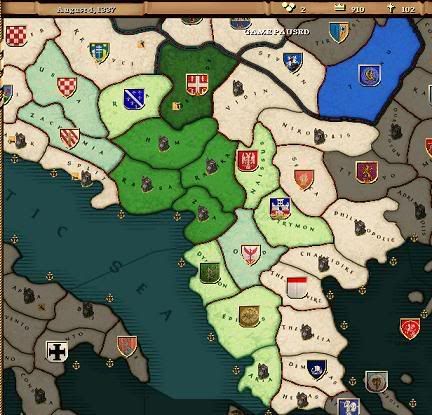
This is yet another AAR about Serbia, starting from 1337, so that Mongols are not so wild, although still very dangerous.
The settings are difficulty-Hard, agresiveness-Normal.
Each time I will play 3 to 5 years, so that you can give comments (if you want).
I have already played as Serbia from 1337, quite successully acquiring the crowns of France and Bulgaria too, but I made 2 crucial mistakes. I arranged a marriage between serbian prince and one very stressed princese. As a consequence, the pince became stressed too and at the end crazed. As he was already at the throne of France, I had to kill them in order to same western teritories. But, that was just another mistake, as my reputation was totally ruined. At the end, my Tzar Dusan had a prestige of 18,000 but the empire was falling apart.
Before AAR, I give you a bit of history:
Tzar Stefan Dusan the Mighty

THE FIRST SERBIAN EMPIRE: The Serbian state reached its first climax of power during the reign of Tsar Stefan Dusan Silni (Mighty), reign 1331-1355 (from 1345 the Tsar). The vast expansion at the expense of the Byzantine state was accomplished without major warfare or open-field battles. It appears more as an opportunistic, or wise exploitation of circumstances that were in Dusan’s favour. However, once in charge of these new territories, Dusan acted with a sense of responsibility and organization.
In 1332 he married Jelena, sister of Bulgarian tsar Aleksandar, a woman of strong will, who had a large influence on him and bore him son Uros and one daughter. Responding to wishes of the restless feudal lords, the young king undertook several successive attacks on Byzantine territories (1334, 1341-1345, 1347-1348). These Serbian victories had influence on a new Byzantine civil war. During the conflict between the minor emperor John V and his regent, John Cantacuzenus, old rivals Venice and Genoa interfered as allies on both sides. Furthermore, supporting Cantacuzenus, the Ottoman Turks saw their first European action and plundered Byzantine dominions. Dusan took the remaining Macedonian towns, with the exception of Thessaloniki, and all of Albania with the exception of Durazzo (Drac). Finally, he entered the important city of Serres, and obtained extensive parts of Greece - Epirus and Thessaly - as far as the Gulf of Corinth. The Serbian state attained its greatest expansion, reaching the Adriatic, Ionian and Aegean seas. King Dusan began thinking along the lines of restoring the glory of The Orthodox Roman Empire under his rule.
As soon as he had taken possession of Serres, the Serbian king styled himself The Master of Romania (Byzantium), and by the end of 1345, had proclaimed himself The Emperor of the Serbs and Romans. With the approval of the Patriarch of Trnovo (Bulgaria) and the (Byzantine) Archbishop of Ohrid, he elevated the Archbishop Joannicius of Pec to the rank of Serbian Patriarch, causing the anathema pronounced by the Byzantine patriarch against the new emperor, patriarch and the new church.
He had himself crowned The Emperor in a solemn ceremony, at a synod in Skoplje on Easter of 1346. Although the imperial title no longer reflected the desire for universal power, it did reveal the plans of the Serbian ruler to impose his mastery on the empire. After fresh victories and territorial expansion, Tsar Dusan appealed to the Venetians for help to conquer Constantinople by sea, but these went unanswered. The Western states were in no mood to sustain his program, and they continued to call him king rather than emperor. Dusan's plan to form a coalition against the Turks and his negotiations with the Pope at Avignon to get himself appointed "captain" of the Crusaders also bore no fruit, although - in a move so typical of medieval East-West political manoeuvre - he did promise a union of Catholic and Serbian Orthodox churches.
Tsar Dusan, for his part, did behave like a Byzantine emperor. State synods, attended by eminent lords, no longer discussed sacred and secular affairs as they had previously, but simply acclaimed the emperor's proposals and laws. At the state synod in Skoplje, in 1349, the Code of Laws was published, and was supplemented later by new provisions in 1354. Dusan's aim was to unify legal practice and introduce system based on greek tradition in the whole country. The code, containing around 200 articles, was based partly on the common law, partly on the old church law, and somewhat on Greek imperial laws, but in its essence it has predominantly autonomous character. It could be viewed as a kind of constitution, as even the Emperor had to obey the supreme authority of The Law.
The Code of Law of Tsar Dusan (1349):
167. On Justice. Imperial order: If the Tsar write a writ either from anger or from love, or by grace for someone, and that writ transgress the Code, and be not according to justice and the law, as written in the Law, the judges shall not believe that writ, but shall only judge and act according to justice.
168. All judges shall judge according to the law, rightly, as is written in the Code, and shall not judge out of fear of the Tsar.
THE DESINTEGRATION OF THE FIRST SERBIAN EMPIRE: Emperor Dusan had large intentions but they were all cut by premature death in 1355, at the age of 48. It is suspected that he was poisoned. He was burried in his foundation, the monastery of Holy Archangels near Prizren (Kosovo). Dusan's minor son Stefan Uros IV Nejaki (Weak), was ruling from 1355 to 1371. The Empire had no national unity or common political identity. It was a mosaic of peoples and political circumstances, united only by the force of the conqueror. As soon as this power disappeared, the empire disintegrated into several provinces and conflict between the nobility started.
Regional lords behaved like rulers on a small scale - they minted money and exacted tolls, depriving the emperor and central government of his rights and revenues. Emperor Uros IV was ultimately forced to divide his power with the most powerful among the Serbian noblemen - Vukasin Mrnjavcevich, the master of northern and eastern Macedonia - giving him the title of king and the rights of a co-ruler in 1365. Uros IV died suddenly in December of 1371, two month after the disasterous battle of Marica, which he did not participate in. He was the last legitimate member of the holy Nemanjich dynasty.


















